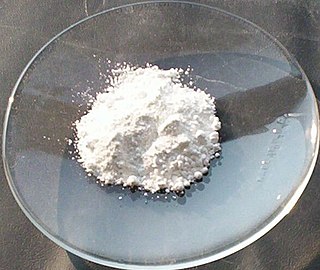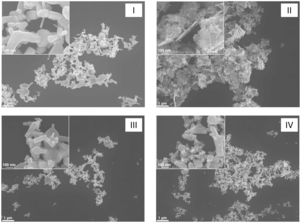
Nanotechnology is the manipulation of matter with at least one dimension sized from 1 to 100 nanometers (nm). At this scale, commonly known as the nanoscale, surface area and quantum mechanical effects become important in describing properties of matter. This definition of nanotechnology includes all types of research and technologies that deal with these special properties. It is common to see the plural form "nanotechnologies" as well as "nanoscale technologies" to refer to research and applications whose common trait is scale. An earlier understanding of nanotechnology referred to the particular technological goal of precisely manipulating atoms and molecules for fabricating macroscale products, now referred to as molecular nanotechnology.

Titanium dioxide, also known as titanium(IV) oxide or titania, is the inorganic compound derived from titanium with the chemical formula TiO
2. When used as a pigment, it is called titanium white, Pigment White 6 (PW6), or CI 77891. It is a white solid that is insoluble in water, although mineral forms can appear black. As a pigment, it has a wide range of applications, including paint, sunscreen, and food coloring. When used as a food coloring, it has E number E171. World production in 2014 exceeded 9 million tonnes. It has been estimated that titanium dioxide is used in two-thirds of all pigments, and pigments based on the oxide have been valued at a price of $13.2 billion.

Zinc oxide is an inorganic compound with the formula ZnO. It is a white powder which is insoluble in water. ZnO is used as an additive in numerous materials and products including cosmetics, food supplements, rubbers, plastics, ceramics, glass, cement, lubricants, paints, sunscreens, ointments, adhesives, sealants, pigments, foods, batteries, ferrites, fire retardants, semi conductors, and first-aid tapes. Although it occurs naturally as the mineral zincite, most zinc oxide is produced synthetically.

Nanomaterials describe, in principle, materials of which a single unit is sized between 1 and 100 nm.

A nanoring is a cyclic nanostructure with a thickness small enough to be on the nanoscale. Note that this definition allows the diameter of the ring to be larger than the nanoscale. Nanorings are a relatively recent development within the realm of nanoscience; the first peer-reviewed journal article mentioning these nanostructures came from researchers at the Institute of Physics and Center for Condensed Matter Physics in Beijing who synthesized nanorings made of gallium nitride in 2001. Zinc oxide, a compound very commonly used in nanostructures, was first synthesized into nanorings by researchers at Georgia Institute of Technology in 2004, and several other common nanostructure compounds have been synthesized into nanorings since. More recently, carbon-based nanorings have been synthesized from cyclo-para-phenylenes as well as porphyrins.

A nanoparticle or ultrafine particle is a particle of matter 1 to 100 nanometres (nm) in diameter. The term is sometimes used for larger particles, up to 500 nm, or fibers and tubes that are less than 100 nm in only two directions. At the lowest range, metal particles smaller than 1 nm are usually called atom clusters instead.

In chemistry, photocatalysis is the acceleration of a photoreaction in the presence of a photocatalyst, the excited state of which "repeatedly interacts with the reaction partners forming reaction intermediates and regenerates itself after each cycle of such interactions." In many cases, the catalyst is a solid that upon irradiation with UV- or visible light generates electron–hole pairs that generate free radicals. Photocatalysts belong to three main groups; heterogeneous, homogeneous, and plasmonic antenna-reactor catalysts. The use of each catalysts depends on the preferred application and required catalysis reaction.

Zinc selenide is the inorganic compound with the formula ZnSe. It is a lemon-yellow solid although most samples have a duller color due to the effects of oxidation. It is an intrinsic semiconductor with a band gap of about 2.70 eV at 25 °C (77 °F), equivalent to a wavelength of 459 nm. ZnSe occurs as the rare mineral stilleite, named after Hans Stille.

In nanotechnology, nanorods are one morphology of nanoscale objects. Each of their dimensions range from 1–100 nm. They may be synthesized from metals or semiconducting materials. Standard aspect ratios are 3-5. Nanorods are produced by direct chemical synthesis. A combination of ligands act as shape control agents and bond to different facets of the nanorod with different strengths. This allows different faces of the nanorod to grow at different rates, producing an elongated object.

Nanochemistry is an emerging sub-discipline of the chemical and material sciences that deals with the development of new methods for creating nanoscale materials. The term "nanochemistry" was first used by Ozin in 1992 as 'the uses of chemical synthesis to reproducibly afford nanomaterials from the atom "up", contrary to the nanoengineering and nanophysics approach that operates from the bulk "down"'. Nanochemistry focuses on solid-state chemistry that emphasizes synthesis of building blocks that are dependent on size, surface, shape, and defect properties, rather than the actual production of matter. Atomic and molecular properties mainly deal with the degrees of freedom of atoms in the periodic table. However, nanochemistry introduced other degrees of freedom that controls material's behaviors by transformation into solutions. Nanoscale objects exhibit novel material properties, largely as a consequence of their finite small size. Several chemical modifications on nanometer-scaled structures approve size dependent effects.
As the world's energy demand continues to grow, the development of more efficient and sustainable technologies for generating and storing energy is becoming increasingly important. According to Dr. Wade Adams from Rice University, energy will be the most pressing problem facing humanity in the next 50 years and nanotechnology has potential to solve this issue. Nanotechnology, a relatively new field of science and engineering, has shown promise to have a significant impact on the energy industry. Nanotechnology is defined as any technology that contains particles with one dimension under 100 nanometers in length. For scale, a single virus particle is about 100 nanometers wide.
Green nanotechnology refers to the use of nanotechnology to enhance the environmental sustainability of processes producing negative externalities. It also refers to the use of the products of nanotechnology to enhance sustainability. It includes making green nano-products and using nano-products in support of sustainability.

Nanomaterials can be both incidental and engineered. Engineered nanomaterials (ENMs) are nanoparticles that are made for use, are defined as materials with dimensions between 1 and 100nm, for example in cosmetics or pharmaceuticals like zinc oxide and TiO2 as well as microplastics. Incidental nanomaterials are found from sources such as cigarette smoke and building demolition. Engineered nanoparticles have become increasingly important for many applications in consumer and industrial products, which has resulted in an increased presence in the environment. This proliferation has instigated a growing body of research into the effects of nanoparticles on the environment. Natural nanoparticles include particles from natural processes like dust storms, volcanic eruptions, forest fires, and ocean water evaporation.

Platinum nanoparticles are usually in the form of a suspension or colloid of nanoparticles of platinum in a fluid, usually water. A colloid is technically defined as a stable dispersion of particles in a fluid medium.

The Center of Excellence (CoE) in Nanotechnology is located at the Asian Institute of Technology campus. It is one of the eight centers of excellence in Thailand.

Core–shell semiconducting nanocrystals (CSSNCs) are a class of materials which have properties intermediate between those of small, individual molecules and those of bulk, crystalline semiconductors. They are unique because of their easily modular properties, which are a result of their size. These nanocrystals are composed of a quantum dot semiconducting core material and a shell of a distinct semiconducting material. The core and the shell are typically composed of type II–VI, IV–VI, and III–V semiconductors, with configurations such as CdS/ZnS, CdSe/ZnS, CdSe/CdS, and InAs/CdSe Organically passivated quantum dots have low fluorescence quantum yield due to surface related trap states. CSSNCs address this problem because the shell increases quantum yield by passivating the surface trap states. In addition, the shell provides protection against environmental changes, photo-oxidative degradation, and provides another route for modularity. Precise control of the size, shape, and composition of both the core and the shell enable the emission wavelength to be tuned over a wider range of wavelengths than with either individual semiconductor. These materials have found applications in biological systems and optics.

Titanium dioxide nanoparticles, also called ultrafine titanium dioxide or nanocrystalline titanium dioxide or microcrystalline titanium dioxide, are particles of titanium dioxide with diameters less than 100 nm. Ultrafine TiO2 is used in sunscreens due to its ability to block ultraviolet radiation while remaining transparent on the skin. It is in rutile crystal structure and coated with silica or/and alumina to prevent photocatalytic phenomena. The health risks of ultrafine TiO2 from dermal exposure on intact skin are considered extremely low, and it is considered safer than other substances used for ultraviolet protection.
Zinc oxide (ZnO) nanostructures are structures with at least one dimension on the nanometre scale, composed predominantly of zinc oxide. They may be combined with other composite substances to change the chemistry, structure or function of the nanostructures in order to be used in various technologies. Many different nanostructures can be synthesised from ZnO using relatively inexpensive and simple procedures. ZnO is a semiconductor material with a wide band gap energy of 3.3eV and has the potential to be widely used on the nanoscale. ZnO nanostructures have found uses in environmental, technological and biomedical purposes including ultrafast optical functions, dye-sensitised solar cells, lithium-ion batteries, biosensors, nanolasers and supercapacitors. Research is ongoing to synthesise more productive and successful nanostructures from ZnO and other composites. ZnO nanostructures is a rapidly growing research field, with over 5000 papers published during 2014-2019.
Nanomaterials are materials with a size ranging from 1 to 100 nm in at least one dimension. At the nanoscale, material properties become different. These unique properties can be exploited for a variety of applications, including the use of nanoparticles in skincare and cosmetics products.
Z-Cote is a commercial zinc oxide line manufactured and owned by BASF. Due to Z-Cote's photo-protective properties it is commonly used in personal care products and sunscreens. It is available in nano, non-nano, coated and uncoated forms. Z-Cote is a derivative of zinc oxide which is Generally Recognized As Safe and Effective (GRASE) by the FDA as a nutrient, cosmetic colour additive, skin protection active ingredient and other OTC products. Manufactured zinc oxide, such as Z-Cote, is only recognised as GRASE by the FDA when it is compliant with the Good manufacturing practice (GMP) standard. The original Sunsmart and Submicro Encapsulation Technologies Z-Cote patent filed in 1991 for UV skin protection expired in 2015.














